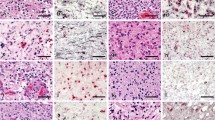Abstract
Oligodendrogliomas and dysembryoplastic neuroepithelial tumors (DNT) are frequently associated with epilepsies and share the presence of oligodendroglia-like cells with small round nuclei and optically empty perinuclear halos. The two entities may be difficult to discriminate in small surgical specimens and the origin and differentiation of the oligodendroglia-like cells has been controversial. To better characterize and distinguish the two entities we examined 25 oligodendrogliomas and 16 DNT immunohistochemically for the presence of the proliferation–associated Ki-67 antigen and the following neural antigens: the α1 subunit of the GABAA receptor (GABAR), N-methyl-d-aspartate receptor subunit 1 (NR1), glutamate decarboxylase, neuronal nuclei antigen (NeuN), the embryonal form of the neural cell adhesion molecule (E-NCAM), synaptophysin, neurofilament protein (NFP), and glial fibrillary acidic protein (GFAP). Labeling indices for the Ki-67 antigens were generally less than 1% in both entities. In oligodendrogliomas, more than 50% of the tumors contained NR1- or E-NCAM-positive oligodendroglia-like cells, whereas NeuN-positive tumor cells were never observed. In DNT, NeuN- and NR1-positive tumor cells were present in 44% of the cases each; E-NCAM positivity was less frequent (19%). In both entities, immunoreactivity of oligodendroglia-like cells for GABAR and glutamate decarboxylase was rare and positivity for synaptophysin and neurofilament protein was absent. Some GFAP-positive tumor cells were present in approximately 70% of the cases in both entities. Except for the striking difference in NeuN positivity, the immunohistochemical profiles of oligodendroglia-like cells in DNT and oligodendrogliomas largely overlap and the differential diagnosis continues to rest mainly on conventional histopathological features. The NR1 positivity and the recently reported generation of action potentials in oligodendroglioma cells are consistent with neuronal differentiation and may contribute to the high epileptogenic potential of oligodendrogliomas.
Similar content being viewed by others
Author information
Authors and Affiliations
Additional information
Received: 10 April 1997 / Accepted: 7 June 1997
Rights and permissions
About this article
Cite this article
Wolf, H., Buslei, R., Blümcke, I. et al. Neural antigens in oligodendrogliomas and dysembryoplastic neuroepithelial tumors. Acta Neuropathol 94, 436–443 (1997). https://doi.org/10.1007/s004010050730
Issue Date:
DOI: https://doi.org/10.1007/s004010050730




